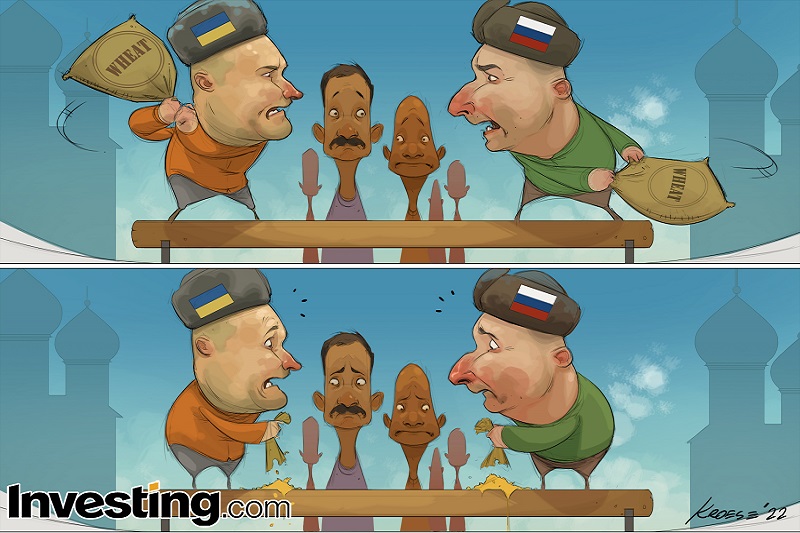By Geoffrey Smith
Investing.com -- The initial panic may be over, but things still look bad for the world’s most important grain.
Wheat futures have come off around 20% from last week’s nine-year high but are still trading at over twice the level of pre-pandemic prices thanks to the uncertainty created by Russia’s invasion of Ukraine. That’s a stark contrast with the more headline-grabbing movements in crude oil, which has now retraced all its gains since spiking as Russia invaded.
Between them, Russia and Ukraine accounted for nearly 30% of global exports last year. The loss of those exports due to war threatens to make bread unaffordable for millions of people who depend on those exports, with all the added risk of political instability that that brings.
Already analysts mutter darkly about the risk that the likely surge in prices will cause a repeat of the Arab Spring, the wave of revolts against autocrats in the Middle East and North Africa a decade ago. For example Egypt, a country of 105 million people, imports over 70% of the wheat it uses for milling, and some two-thirds of that comes from Russia and Ukraine.
“If the conflict results in a sudden and prolonged reduction in food exports by Ukraine and the Russian Federation, it could exert additional upward pressure on international food commodity prices to the detriment of economically vulnerable countries in particular,” the UN Food and Agriculture Office said last week. It estimated that an extra 13 million people worldwide could end up suffering from malnutrition as a result.
The FAO’s preliminary assessment is that between 20%-30% of the areas currently under winter cereals, maize and sunflower seed in Ukraine will either not be planted or remain unharvested during the 2022/23 season. And because of difficulties in accessing pesticides and fertilizer, the yields of these crops are also likely to be lower than in previous years.
However, that is just the direct effect of the war on the crops themselves. Much harder to quantify are the obstacles rising up in the form of financial sanctions and other politically-driven market disruptions. Major shipping lines such as Maersk have already stopped sailings to and from Russian ports. Lloyds of London and other insurance markets have all but closed to Russian cargoes, while the world’s biggest traders such as Bunge (NYSE:BG) and ADM (NYSE:ADM) have said they’re scaling down operations. Russian banks have been largely excluded from international payments channels, making it harder to carry out purchases, even if buyers are confident that they won’t violate Western sanctions by dealing with Russian entities.
The impacts of the war already stretch far out into the future: crop sciences giant Bayer (OTC:BAYRY) said on Monday that its decision on whether to keep sending seeds and pesticides to Russia would depend on the restoration of peace.
To make things worse, there are signs that Russia is now holding grain back from the export market to keep a lid on bread prices at home as a result of the ruble's devaluation: the government passed a decree on Monday banning exports to other countries of the Eurasian Economic Union (the customs union of former Soviet countries that Vladimir Putin cobbled together when he still paid lip-service to soft power) until the end of August. It also banned sugar exports entirely over the same period.
“Despite the false alarm today, we indeed could see some restrictions on exports from Russia in the coming season,” Andrey Sizov, founder of the consultancy SovEcon, said via Twitter on Monday, although he noted that traders are still getting wheat out of the Black Sea at the moment. He’s actually revised his forecast for Russian exports this month up by one-third to 1.6 million tons.
In all, the FAO fears that food prices in general may rise by as much as 22% over the next year as a result of the war, a development that can’t help but stoke the broader wave of inflation washing through the world economy this year.
The situation would be less serious if other major exporting areas of the world weren’t also under stress: but poor harvests in North America over the last year have left inventories below their usual levels and drought in the southern plains states is threatening the current crop of winter wheat. Argentina’s exports this year are likely to stay limited by government efforts to control domestic inflation, while Australia – according to the FAO - has reached its maximum shipment capacity logistically.
Small wonder that the G7 Agriculture Ministers is already sounding the alarm about protectionist measures aiming to shield domestic consumers from rising prices (as in Russia and Argentina).
The G7 last week called on “all countries to keep their food and agricultural markets open and to guard against any unjustified restrictive measures on their exports.”
The ministers added they “will not tolerate artificially inflated prices” and will “fight against any speculative behavior that endangers food security or access to food for vulnerable countries or populations.”
But the signs are that the war has unleashed a degree of volatility that cannot be contained, not least because it comes from all manner of unexpected sources. Only last week, the nickel prices more than doubled due to a violent and disorderly short squeeze. The London Metals Exchange still hasn’t resumed trading in the contract. All the signs are that it will take more than words to keep a lid on wheat prices too – and for food prices more broadly.
